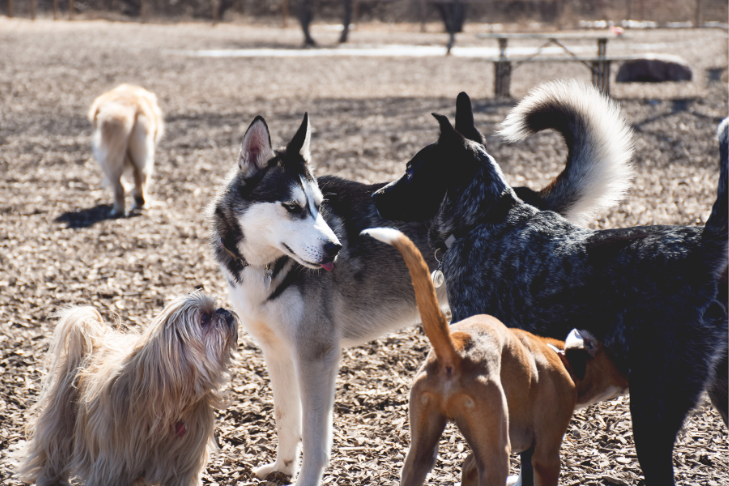Are Dog Parks Safe?

Taking your pup to a dog park can be super fun—it’s like the ultimate playdate! But it can also be stressful, especially if you’ve never done it before. Wondering if it’s safe? What you should look out for? Don’t worry, you’re not alone in these thoughts! Plenty of pet parents are nervous and have reservations when it comes to taking their dogs to a dog park. We’ll go over pet safety and everything you need to know to keep your dog park experience positive and safe.
Dog Park Safety Precautions
The safety of dog parks can vary and can be influenced by several different factors including the park rules, the behavior of other dogs, and the attentiveness of other dog parents. The question, “Are dog parks safe?” can’t necessarily be answered with a simple yes or no—it’s important to consider the specific circumstances and environment of each park.
To have the safest possible visit to the dog park, follow these steps.
- Familiarize Yourself with Park Rules: Most dog parks display their rules prominently at the entrance or on their website. Knowing these guidelines helps ensure you and your dog act responsibly and respectfully during your visit.
- Leave Toys at Home: Bringing toys can lead to possessive behavior or conflicts among dogs. Instead, focus on social interactions and avoid potential triggers for disputes. You can bring chews to reward your pet for good behavior but offer them sparingly to avoid jealousy among other pets.
- Pay Attention: Always keep an eye on your dog’s behavior and the dynamics of the dog park. Watch for signs of stress or aggression and be ready to act if your pet becomes uncomfortable or if the play escalates into conflict.
- Pack Essential Supplies: Come prepared with necessities such as waste bags, water, and a collapsible bowl to make your dog stays hydrated as they are running around enjoying themselves.
- Consider Safety Tools: For an added precaution, some pet parents carry an air horn or a brightly colored water gun. These can be used to safely interrupt a dog fight without putting yourself at risk. Remember, physically attempting to separate dogs who are fighting should always be a last resort.
Health Considerations Before Visiting a Dog Park
- Puppies: Very young puppies, typically under 16 weeks, have immature immune systems and may not have received all their vaccinations yet. Dog parks can be breeding grounds for diseases such as parvovirus, distemper, and kennel cough, which are highly contagious and can be severe or even fatal in puppies. Exposure to these environments before a puppy’s vaccinations are complete significantly increases their risk of contracting these illnesses. It is crucial to wait until dogs have received their full set of vaccinations before considering visits to public dog parks.
- Immunocompromised Dogs: Dogs with weakened immune systems due to health conditions, ongoing medical treatments, or certain chronic illnesses are at a higher risk of infection. Dogs that are compromised should avoid places where the risk of contracting diseases is elevated, like dog parks. Their immune systems are not strong enough to fight off the bacteria, viruses, or parasites that may be present in these communal spaces.

Alternative Activities to Dog Parks
- Interactive Play at Home: Set up a mini agility course in your backyard or living room using items like cones, tunnels, or makeshift jumps. This not only helps in physical exercise but also stimulates your dog’s mind.
- Scheduled Playdates: Arrange one-on-one playdates with a dog friend whose health and behavior you are familiar with. This can be done in a private yard or a quiet park, allowing for socialization without the unpredictability of a dog park.
- Long Walks or Hikes: Explore new trails or neighborhoods where your dog can experience different sights, smells, and sounds, which are great for mental stimulation. Look for areas that are safe and not overcrowded.
- Training Sessions: Use this time to teach your dog new tricks or reinforce old commands. Training sessions not only provide mental stimulation but also strengthen the bond between you and your dog.
- Sniffari Walks: Allow your dog to take the lead on walks, exploring and sniffing around at their own pace. This type of walk prioritizes mental stimulation over physical exercise, perfect for dogs that need a low-stress environment.
- Interactive Toys: Invest in puzzle toys that challenge your dog to think as they attempt to retrieve treats. These toys are excellent for keeping your dog engaged and mentally sharp.
- DIY Indoor Games: Create simple indoor games like hide-and-seek where you hide treats or favorite toys around the house for your dog to find.
While dog parks offer great opportunities for socialization and exercise, they also require a level of caution and preparedness to ensure the safety of all pets involved. By educating yourself on dog park safety and preparing accordingly, you can help create a safe and enjoyable environment for both you and your pet.


